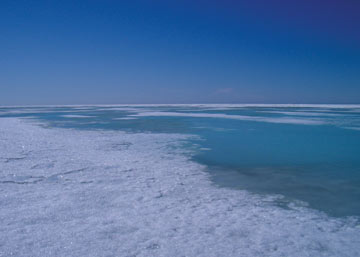|
NEWS NOTES
Climate
Water pours through pores in sea ice
 Ken Golden |
| Melt ponds on Arctic ice have a major influence on Earth’s climate because the dark pools interact with light differently than the surrounding white snow and ice surface. Now scientists have come up with a new model that describes how water moves through the sea ice beneath the ponds, helping them to make better climate predictions. |
Throughout most of the year, the Arctic polar ice cap is an endless white sheet of snow and ice. But in the summer, cobalt blue lakes and rivers atop the ice transform the barren scenery. As the sun beats down on the Arctic, water begins to pool in depressions, gradually forming melt ponds. This process has an important effect on climate because it influences Earth’s albedo — the ratio of how much of the sun’s radiation is reflected back into space to how much Earth absorbs. Light easily bounces off the white polar caps, but the dark seawater pools soak up most of the radiation.
How quickly water in these light-swallowing melt ponds drains into the ocean to expose the white reflective ice again depends on the permeability of the ice beneath it. Now scientists have gained a new understanding of how salt-saturated water moves through sea ice, which will help them to make better predictions for the Arctic ecosystem's response to future climate change.
A team led by Ken Golden of the University of Utah in Salt Lake City developed a mathematical model describing the properties and behavior of sea ice and verified its results with field and laboratory measurements using X-ray microtomography. “As with all other geologic media, permeability and transport are very much controlled by the microstructure of the pore space,” says Hajo Eicken of the University of Alaska at Fairbanks, a co-author of the study published Aug. 16 in Geophysical Research Letters. “In sea ice you have essentially a matrix of solid ice with inclusions of liquid brine, and it’s the size, shape and distribution of these inclusions that control a lot of the material’s properties, including its permeability.”
The team found that water moves through sea ice in a strikingly similar way to how it moves through some crustal rocks, Eicken says. “We have looked at this from the perspective of volcanic rocks, which like ice, form from the melt and then slowly cool, and what’s interesting is that we saw evidence for universal behavior in both systems,” he says.
The new model of how water moves through ice could help researchers make better predictions for future climates, Eicken says. “Alongside modeling clouds, representing the albedo of sea ice in the summer is one of the most important research areas right now in climate modeling,” he says. “And for that, you actually have to know what the permeability is so that you can account for the pooling or the drainage of melt water. This study may give us a much better handle on that,” he adds.
Bonnie Light of the University of Washington in Seattle agrees, saying that climate models suggest that too much melting could lead to a runaway thinning of the Arctic ice cap. “But so far we don’t really understand all the mechanisms by which that could happen. This study provides one piece of the puzzle towards understanding these processes,” she says.
But the findings may also prove useful for understanding how polar ecosystems respond to climate change, Golden says. “The rich food webs in the polar oceans are dependent on algae and bacteria that live in the fluid inclusions in the ice.” The channels that run through sea ice control whether microorganisms such as bacteria and algae can grow and flourish, he says, because they provide the only passage for food. “We need to know more about how nutrients actually get to these different organisms and this model will be very helpful,” Eicken says.
The striking similarities between how water moves through ice and rock also highlight that sea ice could be used as an analogue of other rocks at temperatures close to their melting point, Eicken says. “I am thinking of sea ice as a rock as well and it’s so much easier to study sea ice; nobody would dream of walking around on a lava field and taking samples from that.”
Because the findings suggest that similar porous materials follow the same rules, the study could even shed light on systems found on other bodies in our solar system, Golden adds. “Our results may extend to saline ice on other worlds, such as Jupiter’s icy moon Europa.”

 Subscribe
Subscribe


